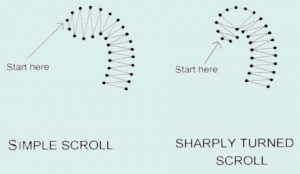Honiton
Honiton Lace 1
Many people perceive Honiton to be a difficult lace, only to be attempted after the other laces. This is a misconception and a very sad one at that. People often put off trying Honiton until it is too late. Later on in life our eyesight deteriorates, it happens to most of us. When this happens learning Honiton can become really hard work. The truth is, Honiton lace is not intrinsically more diffficult than any other lace although it can be more challenging technically. Finer threads aslo make the lace much slower to work so a greater deal of patience is needed. If you like the look of Hontion Lace and want to have a go at it, do it now, don’t put it off until later.
Leadworks are often a problem at Stage 1. Don’t be too concerned about them, the assessor knows quite well that a great many leadworks need to be worked before they look really even. Compare the two lace pieces below. This little shell pattern is typical of a stage 1 piece of Honiton. In the first picture, the leadworks are uneven, some are very pulled but others are quite good. The lacemaker has shown that she knows the techniques required, consistency will come with more practice. If the same piece is worked at Stage 2 (second picture) then far neater leads are expected.
120/2 thread is acceptable as a choice for stage 1 pieces. A piece worked neatly in heavier thread can often look much nicer than a piece in fine thread where the tension is not so good or pinholes are pulled out of shape due to inexperienced sewing. Only move on to finer threads if and so when you feel comfortable to do so. DMC Broder Machine 30 (or equivalent) is a good choice for the coarse thread no matter which fine threads are used. Do not use a finer coarse thread if you move on to using 180/2. Coarse threads are meant to be seen, they give emphasis to the outline of the lace.
Sewings are an integral part of Honiton lace. Try and use a needlepin right from your very first piece. It really is the best tool for taking sewings. In the early stages it is often tempting to use a crochet hook or a beading needle but later when doing raised work you may need to sew into a single pinhole as many as four times. The very fine point of a needlepin will often be the only possible way to achieve this. Confidence with a needlepin will only come with use. And please, never try to do sewings using a wig hook, they often can be very sharp and cut through threads.
Some books will tell you to use fine lace pins and to push them down every other pin as you work, removing the alternate pins. The reasoning behind this is that some pinheads are rather large and if every pin were pushed down, the pinheads would lie on top of each other and the threads would catch and break. The only problem with this method is that it can result in a wavy pinhole edge. A better idea is to use very fine Duchesse pins. These have tiny heads so every pin can be pushed down which results in a far neater edge.
You are asked to show a purl edge. Although it is not specifically asked for in the requirements, it is a good idea to show that you can do both left and right handed purls. A simple butterfly design with left handed purls along one edge and right handed purls along the other edge, can show this to good effect.
Finally, do not automatically unpick any mistakes you have made. Ask yourself, will anyone notice other than myself? Remember that fine threads will not stand very much unpicking. These are no exhibition pieces, they are learning pieces. Sometimes it is better to leave a mistake and learn from it rather then risk breaking threads. But always write down your mistakes to let the assessor know you recognise what you have done wrong. You will not be penalised.
© Extracted from The Journal of the Australian Lace Guild ~ August 2013
Stage One Proficiency
Stage Two Proficiency
Stage Three Proficency

